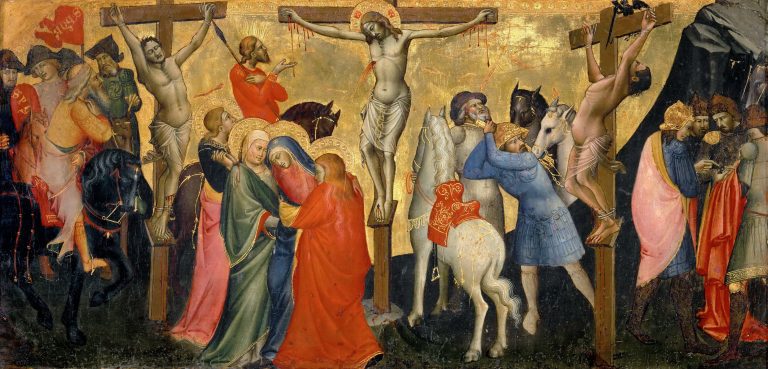By Curtis Mitch
Curtis Mitch is a writer, editor, and research fellow at the St. Paul Center. He has been a contributor to the popular apologetics series Catholic for a Reason (Emmaus Road Publishing); he has co-authored a commentary on the Gospel of Matthew with Edward Sri in the Catholic Commentary on Sacred Scripture series (Baker Academic); and he is the principal annotator and associate editor of the Ignatius Catholic Study Bible (Ignatius Press). He has also been a guest lecturer in theology at Franciscan University and an online instructor in theology for Catholic Distance University.

Every year in Lent the Church directs our thoughts to Jesus on the Cross. This is the sacred center of everything we believe and celebrate as Catholic Christians. Take away the Cross and you take away our salvation. Take away our salvation and everything “good” about the good news of the gospel evaporates.
Most of us sense the importance of Jesus on the Cross, but how many of us really understand what was taking place? I would guess that very few churchgoers could articulate how Jesus’s death redeemed us from our sins. Of course, our redemption is a mystery of faith, and that means we’ll never be able to wrap our minds all the way around it. An exhaustive understanding of what Christ accomplished on Good Friday is simply out of the question, at least in this life. But the Lord wants us to grasp something essential about this mystery; otherwise, the New Testament would not speak so much about it.
What, then, was Jesus doing on the Cross?
A Common Answer: Penal Substitution
There is a common answer to this question given in churches throughout America, most of them non-Catholic. This is the claim that Jesus suffered the punishments of God that are due to sin, a view that can be traced back to the sixteenth-century founders of Protestantism, Martin Luther and John Calvin. Their reasoning goes something like this: every sin angers God, and every sin deserves to be punished by God; so, unless God intervenes and finds a way to divert his punishment away from sinners, we are all doomed to damnation.
That’s precisely why God sent his Son into the world. According to this interpretation, Christ came among us so that he could take the punishments for our sins upon himself on the Cross. He became a penal substitute on our behalf. He hurled himself in front of the oncoming train of the Father’s fury and bore the full brunt of it so that you and I don’t have to. He interposed himself between the wrath of God and the world of sinners, so that God could vent his dreadful anger without harm to those who take refuge behind Jesus.1
This common explanation is attractive for its simplicity and clarity. Nevertheless, its perks are outweighed by its problems. First, this understanding of the Cross is a novelty of the sixteenth century; it was all but unknown during the first 1500 years of Christian history and theology. That alone doesn’t make it wrong, but it should certainly give us pause—all the more so when we consider how deeply the Church has meditated upon Christ’s passion over the ages. Second, insofar as the theory of penal substitution interprets the Cross as God the Father unleashing his wrath on God the Son, it wrongly introduces opposition into the Trinity. Our faith teaches that the Father, Son, and Spirit live as a communion of Persons united in a flow of infinite love that is eternally given and eternally received. It likewise teaches that the Trinity is immutable, without any potential for change in its way of being. It is therefore impossible to pit one Person of the Trinity against another as Punisher against the Punished, even for an instant. Third, if Jesus was punished for our sins on the Cross, then the justice of God has not actually been satisfied. In fact, the whole thing is a monstrous injustice! Punishing a person who is innocent for the crimes of the guilty violates the principles of justice to the core. No amount of theological gymnastics can justify the Father imposing a criminal sentence on One who has committed no crimes whatsoever. Fourth, if Jesus suffered and died as our substitute, then it’s hard to explain why Christians still experience suffering and death even after their sins are forgiven. The whole notion of Jesus bearing these painful burdens “in our place” and “instead of us” seems emptied of real meaning.
A Catholic Answer: Vicarious Satisfaction
That brings us to one of the classical Catholic answers to the question.2 If the crucified Jesus was not enduring the punishments of the Father as our substitute, then what was he doing on the Cross? He was loving the Father and the fallen human family to the fullest extent possible. In a word: Jesus was paying the debt that sin incurred with God. Instead of penal substitution, he accomplished a vicarious satisfaction. Let’s explain.
When Jesus came to Jerusalem for the last time, he was asked by a lawyer of the Pharisees:
Teacher, which is the great commandment in the law?” And he said to him, “You shall love the Lord your God with all your heart, with all your soul, and with all your mind. This is the first and great commandment. And a second is like it, You shall love your neighbor as yourself. On these two commandments depend all the law and the prophets. (Matt 22:36–40)
In saying this, Jesus reveals the deepest intent of God’s law. Rabbinic tradition enumerated a total of 613 commandments in the Torah, a vast legislation that covered an array of conduct related to personal life, social life, religious life, etc. Despite this great diversity of laws, Jesus insists that the entire law serves a common aim: To teach God’s people how to love. Every commandment, every precept, is ordered in some way to loving God and loving neighbor. That’s the positive side. But there’s a negative implication as well. Jesus’s words also cast a sidelight on the mystery of sin. If every precept of God’s law calls us to love, then every sin against the law is a refusal to love, every transgression a failure to love. In short, this means that every sin creates a debt of love that is owed to God and others but is wrongly withheld. Human history, which in spiritual terms is a sorry tale of rebellion against the Lord and his law, is a story of men and women racking up a universe of debt. Woefully less love is given to God and neighbor than what is owed in justice. And in our fallen state, we simply don’t have enough love to make up for what is lacking. The principle balance of love’s debt is unpayable for sinners.3
This is why God sent his Son into the world: to fulfill a mission of love. Jesus came to do for us what we could not do for ourselves. He took to himself a human nature so that he could love the Father and the human family to the fullest extent possible as a man and thus pay the debts of love that your sins and mine have incurred. And Jesus was uniquely qualified for this task, first, because he himself was and remains sinless (without debts of his own), and second, because his human will was and remains the instrument of his divine will (which is infinitely powerful). As true man, Christ acted in our name and on our behalf; as true God, his actions were infinitely efficacious.
Jesus, then, was the one man who could love to an infinite degree and thus satisfy the debt of love that our race incurred with God. Every refusal to love, which is the essence of every sin, received its full and just compensation from the Son of God, who loved God and neighbor like no one else could. In fact, because Jesus loved with an infinite love, he satisfied our debts superabundantly (Rom 5:20–21). He not only paid what we owed, bringing us back to ground zero, so to speak, but he has made us spiritually rich (2 Cor 8:9).
How, then, does one explain the violence of the crucifixion? According to classical Catholicism, it is not the violence of an angry Father hammering down on the Son that is on display. It is rather the full intensity of Christ’s love—the heroism of enduring even the very worst for one’s beloved—that is revealed in these awful circumstances. Jesus was paying our debts by fulfilling the Torah’s double commandment of charity—loving the Father in a perfect act of obedience and loving us in a perfect act of service intended for our eternal benefit. His love is perfect because it’s perfectly selfless. A love that ends in death, especially an excruciating one, is purest because it neither seeks nor expects anything in return. It is sheer giving without any thought of getting.
This is precisely where the accent falls in the teaching of the New Testament. One could say that Jesus himself gave us a golden key when he said at the Last Supper: “Greater love has no man than this, that a man lay down his life for his friends” (John 15:13). With these words Jesus was preparing his followers to view his passion with the eyes of faith. When his hour comes, they must not be blinded by the evil that rages all around him; in the midst of the blood and brutality, they must see Jesus’s love reaching its greatest intensity, redeeming the world from the debts of its sin.4
What, then, was Jesus doing on the Cross? He was loving. He was substituting his obedience for our disobedience.5 He was loving God and neighbor vicariously (in our name, while acting in our nature) and superabundantly (compensating for our refusals to love, and even paying more than we owed in the first place). This is love extravagant.
1. Advocates of this interpretation claim to find support for this view in several passages of Scripture, e.g., Isa 53:4–6; 2 Cor 5:21; Gal 3:13.
2. I say “one” of the answers because Catholic saints and theologians have worked out several models for understanding how Jesus’s death makes satisfaction for sin.
3. This is one of the lessons of the Parable of the Unforgiving Servant in Matthew 18:23–35.
4. Other passages of the NT that accent the love of Christ on the Cross include Rom 5:8; Gal 2:20; Eph 5:2.
5. CCC 615.
You Might Also Like
Where do we find the Mass in the Bible? What is the relationship between the two? In ten beautifully produced lessons, Parousia: The Bible and the Mass answers these questions and more.


